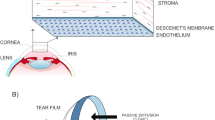Abstract
The corneal endothelium forms a leaky barrier between the corneal stroma and the aqueous humor of the anterior chamber. This cell monolayer maintains the corneal stroma in a state of relative dehydration, a process called deturgescence, which is required in order to obtain corneal stromal transparency. Endothelial dysfunctions lead to visual impairment that ultimately can only be treated surgically via the corneal transplantation of a functional endothelium. Shortages of corneas suitable for transplantation has motivated research toward new alternatives involving in vitro corneal endothelial cell (CEC) expansion.
This chapter describes current methods that allow isolate and culture CECs. In brief, Descemet membrane is peeled out of the cornea and digested in order to obtain CECs. Cells are then seeded and cultured.
Access this chapter
Tax calculation will be finalised at checkout
Purchases are for personal use only
Similar content being viewed by others
References
Bonanno JA (2003) Identity and regulation of ion transport mechanisms in the corneal endothelium. Prog Retin Eye Res 22(1):69–94
Joyce NC, Harris DL, Mello DM (2002) Mechanisms of mitotic inhibition in corneal endothelium: Contact inhibition and tgf-beta2. Invest Ophthalmol Vis Sci 43(7):2152–2159
Yoshida K, Kase S, Nakayama K, Nagahama H, Harada T, Ikeda H, Harada C, Imaki J, Ohgami K, Shiratori K, Ilieva IB, Ohno S, Nishi S, Nakayama KI (2004) Involvement of p27kip1 in the proliferation of the developing corneal endothelium. Invest Ophthalmol Vis Sci 45(7):2163–2167
Matsuda M, Sawa M, Edelhauser HF, Bartels SP, Neufeld AH, Kenyon KR (1985) Cellular migration and morphology in corneal endothelial wound repair. Invest Ophthalmol Vis Sci 26(4):443–449
Edelhauser HF (2006) The balance between corneal transparency and edema: The proctor lecture. Invest Ophthalmol Vis Sci 47(5):1754–1767. https://doi.org/10.1167/iovs.05-1139
American Academy of Opthalmology A (1997) Corneal endothelial photography - three~year revision. Ophthalmology 104(8):1360–1365
Talajic JC, Straiko MD, Terry MA (2013) Descemet’s stripping automated endothelial keratoplasty: then and now. Int Ophthalmol Clin 53(2):1–20. https://doi.org/10.1097/IIO.0b013e31827eb6ba
EBAA (2016) 2015 eye banking statistical report. Washington, DC
Proulx S, Audet C, Uwamaliya J, Deschambeault A, Carrier P, Giasson CJ, Brunette I, Germain L (2009) Tissue engineering of feline corneal endothelium using a devitalized human cornea as carrier. Tissue Eng Part A 15(7):1709–1718. https://doi.org/10.1089/ten.tea.2008.0208
Kinoshita S, Koizumi N, Ueno M, Okumura N, Imai K, Tanaka H, Yamamoto Y, Nakamura T, Inatomi T, Bush J, Toda M, Hagiya M, Yokota I, Teramukai S, Sotozono C, Hamuro J (2018) Injection of cultured cells with a rock inhibitor for bullous keratopathy. N Engl J Med 378(11):995–1003. https://doi.org/10.1056/NEJMoa1712770
Li W, Sabater AL, Chen YT, Hayashida Y, Chen SY, He H, Tseng SC (2007) A novel method of isolation, preservation, and expansion of human corneal endothelial cells. Invest Ophthalmol Vis Sci 48(2):614–620. https://doi.org/10.1167/iovs.06-1126
Senoo T, Obara Y, Joyce NC (2000) Edta: a promoter of proliferation in human corneal endothelium. Invest Ophthalmol Vis Sci 41(10):2930–2935
Engler C, Kelliher C, Speck CL, Jun AS (2009) Assessment of attachment factors for primary cultured human corneal endothelial cells. Cornea 28(9):1050–1054. https://doi.org/10.1097/ICO.0b013e3181a165a3
Chng Z, Peh GS, Herath WB, Cheng TY, Ang HP, Toh KP, Robson P, Mehta JS, Colman A (2013) High throughput gene expression analysis identifies reliable expression markers of human corneal endothelial cells. PLoS One 8(7):e67546. https://doi.org/10.1371/journal.pone.0067546
Bartakova A, Alvarez-Delfin K, Weisman AD, Salero E, Raffa GA, Merkhofer RM Jr, Kunzevitzky NJ, Goldberg JL (2016) Novel identity and functional markers for human corneal endothelial cells. Invest Ophthalmol Vis Sci 57(6):2749–2762. https://doi.org/10.1167/iovs.15-18826
Ueno M, Asada K, Toda M, Schlotzer-Schrehardt U, Nagata K, Montoya M, Sotozono C, Kinoshita S, Hamuro J (2016) Gene signature-based development of elisa assays for reproducible qualification of cultured human corneal endothelial cells. Invest Ophthalmol Vis Sci 57(10):4295–4305. https://doi.org/10.1167/iovs.16-19806
Cheong YK, Ngoh ZX, Peh GS, Ang HP, Seah XY, Chng Z, Colman A, Mehta JS, Sun W (2013) Identification of cell surface markers glypican-4 and cd200 that differentiate human corneal endothelium from stromal fibroblasts. Invest Ophthalmol Vis Sci 54(7):4538–4547. https://doi.org/10.1167/iovs.13-11754
Hamuro J, Toda M, Asada K, Hiraga A, Schlotzer-Schrehardt U, Montoya M, Sotozono C, Ueno M, Kinoshita S (2016) Cell homogeneity indispensable for regenerative medicine by cultured human corneal endothelial cells. Invest Ophthalmol Vis Sci 57(11):4749–4761. https://doi.org/10.1167/iovs.16-19770
Okumura N, Hirano H, Numata R, Nakahara M, Ueno M, Hamuro J, Kinoshita S, Koizumi N (2014) Cell surface markers of functional phenotypic corneal endothelial cells. Invest Ophthalmol Vis Sci 55(11):7610–7618. https://doi.org/10.1167/iovs.14-14980
Okumura N, Ishida N, Kakutani K, Hongo A, Hiwa S, Hiroyasu T, Koizumi N (2017) Development of cell analysis software for cultivated corneal endothelial cells. Cornea 36(11):1387–1394. https://doi.org/10.1097/ICO.0000000000001317
Toda M, Ueno M, Hiraga A, Asada K, Montoya M, Sotozono C, Kinoshita S, Hamuro J (2017) Production of homogeneous cultured human corneal endothelial cells indispensable for innovative cell therapy. Invest Ophthalmol Vis Sci 58(4):2011–2020. https://doi.org/10.1167/iovs.16-20703
Peh GS, Chng Z, Ang HP, Cheng TY, Adnan K, Seah XY, George BL, Toh KP, Tan DT, Yam GH, Colman A, Mehta JS (2015) Propagation of human corneal endothelial cells: a novel dual media approach. Cell Transplant 24(2):287–304. https://doi.org/10.3727/096368913X675719
Beaulieu Leclerc V, Roy O, Santerre K, Proulx S (2018) Tgf-beta1 promotes cell barrier function upon maturation of corneal endothelial cells. Sci Rep 8(1):4438. https://doi.org/10.1038/s41598-018-22821-9
Acknowledgements
Procurement of eyes for research was possible thanks to a partnership with Héma-Québec, the CUO Eye Bank, and a “Fonds de recherche du Québec – Santé (FRQ-S)” Vision Health Research Network (VHRN) Infrastructure Program (S.P.). I.X. was a recipient of Master Training Awards from Université Laval (Wilbrod-Bhérer), the Fondation du CHU de Québec, the LOEX Center, and the VHRN.
Author information
Authors and Affiliations
Corresponding author
Editor information
Editors and Affiliations
Rights and permissions
Copyright information
© 2020 Springer Science+Business Media, LLC, part of Springer Nature
About this protocol
Cite this protocol
Santerre, K., Xu, I., Thériault, M., Proulx, S. (2020). In Vitro Expansion of Corneal Endothelial Cells for Transplantation. In: Ahearne, M. (eds) Corneal Regeneration. Methods in Molecular Biology, vol 2145. Humana, New York, NY. https://doi.org/10.1007/978-1-0716-0599-8_2
Download citation
DOI: https://doi.org/10.1007/978-1-0716-0599-8_2
Published:
Publisher Name: Humana, New York, NY
Print ISBN: 978-1-0716-0598-1
Online ISBN: 978-1-0716-0599-8
eBook Packages: Springer Protocols



